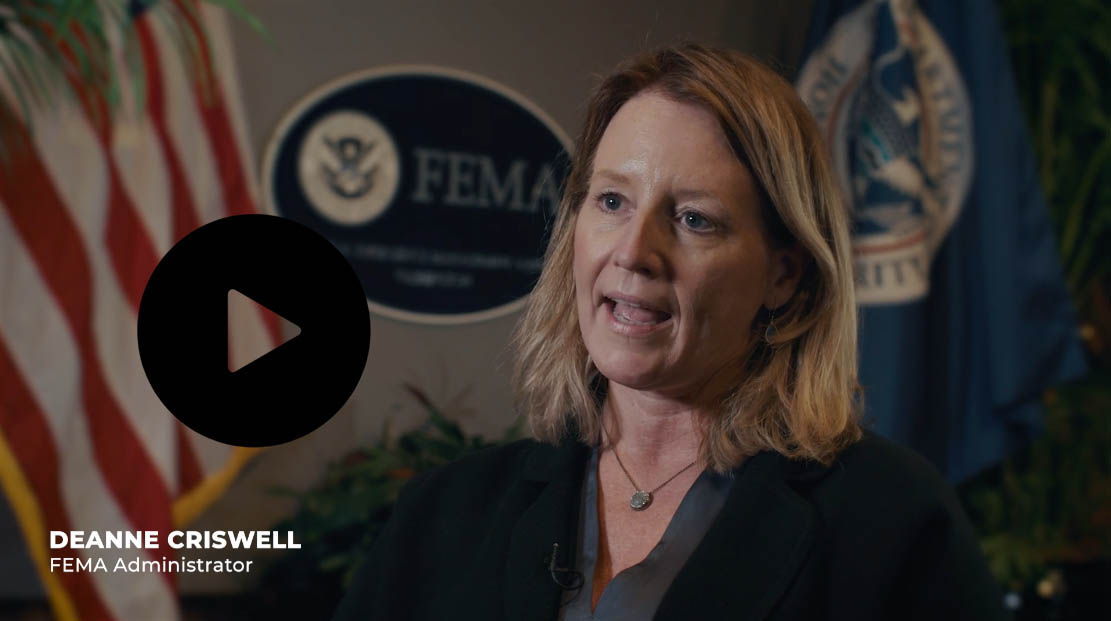Select Events and Historical Landmarks
Hurricane Andrew & Creation of SREMAC
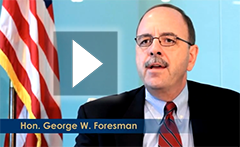 In 1992, when Hurricane Andrew devastated Florida, it became apparent that even with federal resources, states would need to call upon one another in times of emergencies.
In 1992, when Hurricane Andrew devastated Florida, it became apparent that even with federal resources, states would need to call upon one another in times of emergencies.
As a result, the Southern Governors' Association (SGA) coordinated with Virginia's Department of Emergency Services to develop a state-to-state mutual aid agreement: the Southern Regional Emergency Management Assistance Compact (SREMAC), which was adopted in 1993. 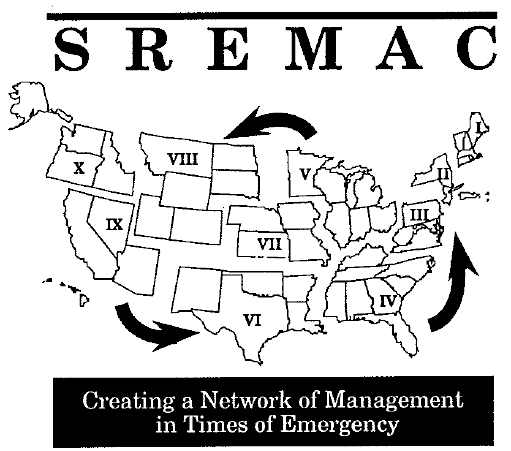
Select the "Play" icon (in the image above) to hear about Hurricane Andrew's role in the development of EMAC.
1993
SREMAC Broadened to EMAC
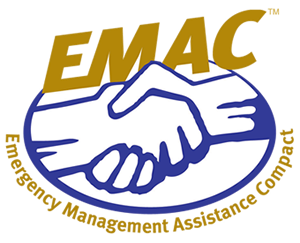 In January 1994, the SGA voted to “de-regionalize” the compact by striking the “Southern Regional” part from the name and opening the membership to all states---hence SREMAC evolved to become EMAC!
In January 1994, the SGA voted to “de-regionalize” the compact by striking the “Southern Regional” part from the name and opening the membership to all states---hence SREMAC evolved to become EMAC!
In 1995, the state leadership asked NEMA, the National Emergency Management Association, to administer the compact on behalf of the EMAC Member States. Administration at that time was shared responsibility among the NEMA staff.
1994
Hurricane Opal - Florida
 The first deployment of resources upon broadening SREMAC to EMAC was in 1995 when Mississippi deployed 25 personnel to Florida in response to Hurricane Opal.
The first deployment of resources upon broadening SREMAC to EMAC was in 1995 when Mississippi deployed 25 personnel to Florida in response to Hurricane Opal.
1995
October 1996 - Congress consents to the Emergency Management Assistance Compact
Oct. 19, 1996
Resolved by the Senate and House of Representatives of the United States of America in Congress assembled,
SECTION 1. CONGRESSIONAL CONSENT
The Congress consents to the Emergency Management Assistance Compact entered into by Delaware, Florida, Georgia, Louisiana, Maryland, Mississippi, Missouri, Oklahoma, South Carolina, South Dakota, Tennessee, Virginia, and West Virginia. The compact reads substantially as follows: Emergency Management Assistance Compact
See the full text on Congress.gov
1996
August 1998 - Hurricane Bonnie
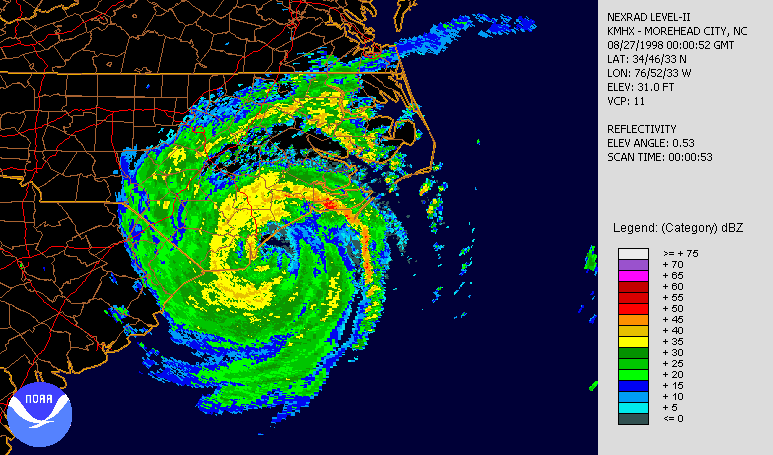 Hurricane Bonnie made landfall as a borderline Category 2 - Category 3 storm with wind gusts of up to 104 mph. Seventeen (17) personnel were deployed to assist North Carolina and Virginia.
Hurricane Bonnie made landfall as a borderline Category 2 - Category 3 storm with wind gusts of up to 104 mph. Seventeen (17) personnel were deployed to assist North Carolina and Virginia.
Photo Credit: NOAA
1998
September 1998 - Hurricane Georges
 Hurricane Georges was a powerful Category 4 hurricane that made seven landfalls along its path. Mississippi, Louisiana, Florida, and Texas requested resources. In total, 54 resources were deployed through EMAC to assist.
Hurricane Georges was a powerful Category 4 hurricane that made seven landfalls along its path. Mississippi, Louisiana, Florida, and Texas requested resources. In total, 54 resources were deployed through EMAC to assist.
Hurricane Georges making its final landfall on September 28 at 2043 UTC. This image was produced from data from NOAA-14, provided by NOAA. Georges made landfall as a Category 2 hurricane in Biloxi, Mississippi and it was still at Category 1 strength at the time this image was captured. Photo Credit: http://en.wikipedia.org/wiki/Hurricane_Georges
1998
October 1998 - Florida Wildfires
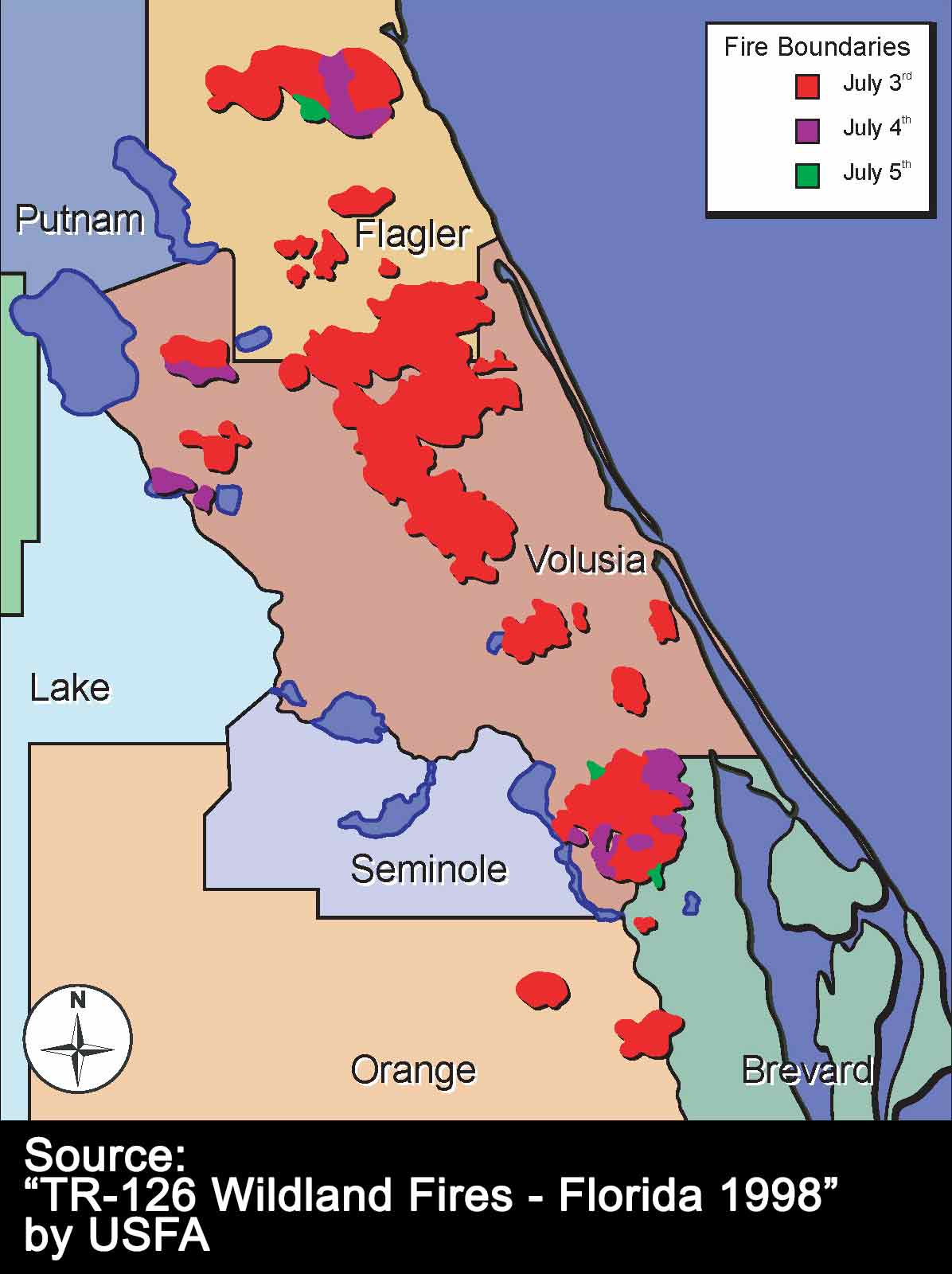 457 deployed including fire service, A-Teams, and National Guard resources were deployed through EMAC in response to Florida wildfires.
457 deployed including fire service, A-Teams, and National Guard resources were deployed through EMAC in response to Florida wildfires.
Approximated numbers of personnel based upon data on personnel in brush trucks. Missing numbers include two National Guard Task Forces with costs totaling $666,776 where the # of PAX was not stated.
Source: EMAC Situation Reports dated October 7, 1998 in NEMA's archives.
1998
September 1999 - Hurricane Floyd
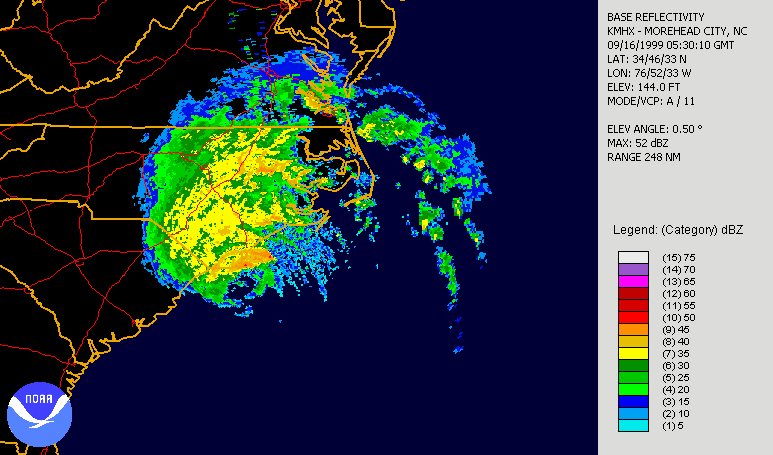 Hurricane Floyd was a very powerful Category 4 hurricane that impacted several states, including North Carolina, Virginia, and Florida.
Hurricane Floyd was a very powerful Category 4 hurricane that impacted several states, including North Carolina, Virginia, and Florida.
Through EMAC, 385 personnel were deployed in this response.
Source: Situation reports NEMA's archives. Photo Credit: Hurricane Floyd making landfall in North Carolina on September 16th, 1999. Radar is long range base relectivity. Created using NCDC JAVA NEXRAD tool File created by Hello32020
http://en.wikipedia.org/wiki/Hurricane_Floyd
1999
9/11 Terrorist Attacks
 EMAC was requested and deployed in response to the World Trade Centers Terrorist attack and the attack on the Pentagon.
EMAC was requested and deployed in response to the World Trade Centers Terrorist attack and the attack on the Pentagon. Thirty personnel deployed in this response. Watch the video, by selecting the image on the right, to hear from Oklahoma State Emergency Management Director Albert Ashwood share his EMAC experience.
2001
September 2003 - Hurricane Isabel
 Hurricane Isabel After Action Review dated January 6, 2004, credits 26 missions with 155 personnel deployed from 15 EMAC Member States in response to Hurricane Isabel.
Hurricane Isabel After Action Review dated January 6, 2004, credits 26 missions with 155 personnel deployed from 15 EMAC Member States in response to Hurricane Isabel.
Image: The eye of Hurricane Isabel approaches North Carolina's Outer Banks in this true-color Moderate Resolution Imaging Spectroradiometer (MODIS) image captured by the Terra satellite on September 18, 2003 at 11:55 am US Eastern time.
Photo Credit: Jacques Descloitres, MODIS Rapid Response Team, NASA/GSFC - http://visibleearth.nasa.gov/view_rec.php?id=5868
2003
Hurricanes Bonnie, Charley, Frances, Ivan, & Jeanne
 The 2004 hurricane season was one of the most challenging periods in U.S. disaster response and recovery history. It tested Emergency Management Assistance Compact (EMAC) policies, plans, and procedures in circumstances heretofore unseen in scope, magnitude, intensity, and duration. Over a period of 85 days, 38 States deployed nearly 800 civilian personnel and 1200 National Guard personnel in the largest use of State-to-State mutual assistance in history.
The 2004 hurricane season was one of the most challenging periods in U.S. disaster response and recovery history. It tested Emergency Management Assistance Compact (EMAC) policies, plans, and procedures in circumstances heretofore unseen in scope, magnitude, intensity, and duration. Over a period of 85 days, 38 States deployed nearly 800 civilian personnel and 1200 National Guard personnel in the largest use of State-to-State mutual assistance in history.
Hear about the issues with accountability of personnel during the 2004 Hurricanes.
Download the 2004 EMAC AAR to learn more about the lessons learned and improvements that would soon come to the Compact.
2004
Hurricanes Katrina, Wilma, and Rita
 The largest mutual aid deployment in our nation's history - the response to Hurricanes Katrina, Rita, and Wilma lasted 215 consecutive days. States deployed 67,000 personnel to Florida, Louisiana, Texas, Alabama, Mississippi, the National Response Coordination Center (NRCC) and Region IV and VI Regional Response Coordination Centers (RRCCs).
The largest mutual aid deployment in our nation's history - the response to Hurricanes Katrina, Rita, and Wilma lasted 215 consecutive days. States deployed 67,000 personnel to Florida, Louisiana, Texas, Alabama, Mississippi, the National Response Coordination Center (NRCC) and Region IV and VI Regional Response Coordination Centers (RRCCs).
Learn more by watching the "EMAC Response to Hurricane Katrina" video.
2005
2005 Hurricane Season Facts
Some interesting facts about the 2005 deployments include the following (from the 2005 EMAC After-Action Report):

- More than 1,300 search-and-rescue personnel from 16 states searched more than 22,300 structures and rescued 6,582 people.
- More than 2,000 healthcare professionals from 28 states treated more than 160,000 patients in the days and weeks after the storms under the most primitive of conditions.
- Nearly 3,000 fire/hazmat personnel from 28 states deployed.
- Two hundred engineers from nine states assisted.
- More than 6,880 sheriff's deputies and police officers from 35 states and countless local jurisdictions deployed across Louisiana and Mississippi—a total of 35% of all of the resources deployed.
- More than 100 animal rescue personnel from 4 states deployed; one team alone sheltered approximately 1,500 animals.
2006
Implementation of 2005 Hurricane Season Lessons Learned
During the first two weeks of the 2005 response, personnel deploying through EMAC respresent approximately 53% of the total response (GAO-07-854 EMAC Report). Unfortunately, the vast majority of those deployed had never heard of EMAC and were not familiar with the EMAC Process.
To engage the multitude of response and recovery disciplines, the EMAC Advisory Group was established in 1996, composed of the national organizations that have been or may be deployed through EMAC.
In addition to updating procedures, the EMAC Operations System, and reimbursement guidance, states established enabling mechanisms and updated plans and procedures to include local resource providers. The EMAC Member States established training and exercise programs for EMAC and committed to educating all response and recovery personnel on EMAC so that mutual aid through EMAC can be effective and efficient.
2007
California Wildfires
 The 2007 California wildfires were a series of @ thirty wildfires across Southern California that destroyed over 1,500 homes and 970,977 acres of land between Santa Barbara County and the U.S. - Mexico border. The wildfires killed 14 people and injured 160 (including 124 firefighters).
The 2007 California wildfires were a series of @ thirty wildfires across Southern California that destroyed over 1,500 homes and 970,977 acres of land between Santa Barbara County and the U.S. - Mexico border. The wildfires killed 14 people and injured 160 (including 124 firefighters).
Arizona deployed a 1 Type I Engine Strike Team (21 personnel) and New Mexico deployed 2 Type I Engine Strike Teams (42 personnel). Following the presidential declaration, resources were switched from an EMAC deployment to the Federal Wildland System (with the federal government picking up 100% of cost - 90/10 under EMAC).
Event Source Image Source: NASA satellite photo (provided by NSPO, Taiwan National Space Organization) from October 24, 2007, showing the active fire zones and smoke plumes.
2007
Spring Flooding
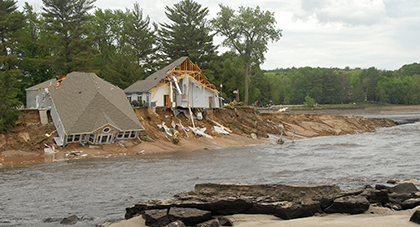 Months of heavy rains resulted in rivers overflowing their banks. After several weeks, levees at numerous locations broke including flooding in Illinois, Iowa, Michigan, Minnesota, Missouri, and Wisconsin. Through EMAC, 227 personnel were deployed to assist in the response.
Months of heavy rains resulted in rivers overflowing their banks. After several weeks, levees at numerous locations broke including flooding in Illinois, Iowa, Michigan, Minnesota, Missouri, and Wisconsin. Through EMAC, 227 personnel were deployed to assist in the response. Photo Credit: U.S. Air Force photo by Master Sgt. Paul Gorman/Released
2008
Hurricanes Hanna, Gustav, & Ike
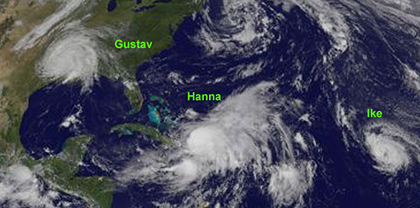 Forty-one states sent 12,279 personnel and 200,000 animal cages to Louisiana, Texas, Florida, Mississippi, the Region IV RRCC, the Region VI RRCC, and the NRCC in response to the hurricanes.
Forty-one states sent 12,279 personnel and 200,000 animal cages to Louisiana, Texas, Florida, Mississippi, the Region IV RRCC, the Region VI RRCC, and the NRCC in response to the hurricanes.
77% of resources were from the National Guard and 33% were state and local resources from agriculture and forestry, animal response, emergency management, fire, human services, law enforcement, and search and rescue.
Photo Credit: This GOES satellite image from September 2 shows Gustav (over Texas), Hanna (in the Bahamas), and Ike. NASA/NOAA GOES Project
2008
Presidential Inauguration
 Thirty-eight (38) missions with 91 personnel were deployed in support of the President Obama Inauguration.
Thirty-eight (38) missions with 91 personnel were deployed in support of the President Obama Inauguration. An additional 10,277 National Guard resources were on standby.
Photo credit:
2009
Ice Storms
 States deployed 714 personnel in 43 missions through EMAC in support of Kentucky and Arkansas.
States deployed 714 personnel in 43 missions through EMAC in support of Kentucky and Arkansas.Photo Credit: NOAA
2009
Spring Floods
 Record-breaking snowfalls and spring rains caused severe flooding in parts of the Missouri and Red Rivers in North Dakota, Minnesota, and South Dakota. During the 2 month flooding, 1031 personnel deployed to assist with the response. Seventy-one percent (71%) of the response was National Guard resources who primarily assisted with sandbagging efforts from the ground and air. Other resources included pet sheltering, traffic control and security, incident management teams, EMS units, and NRCC support.
Record-breaking snowfalls and spring rains caused severe flooding in parts of the Missouri and Red Rivers in North Dakota, Minnesota, and South Dakota. During the 2 month flooding, 1031 personnel deployed to assist with the response. Seventy-one percent (71%) of the response was National Guard resources who primarily assisted with sandbagging efforts from the ground and air. Other resources included pet sheltering, traffic control and security, incident management teams, EMS units, and NRCC support.Photo credit: Star Tribune/Minneapolus-St. Paul 2009 - Rights Purchased
2009
Alabama Tornadoes
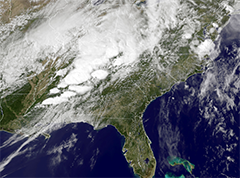 April 27-28, 2011 was one of the deadliest tornado outbreaks in our nation's history. At least 250 people had been killed by the morning of the second day across 6 states. Alabama was the hardest hit state with 162 confirmed dead with days of the outbreak. EMAC was utilized in 21 missions deploying 251 personnel. Among those resources were search and rescue resources, law enforcement, public information officers, public assistance, HAM radio operators, EMS, and volunteer donation coordination support.
April 27-28, 2011 was one of the deadliest tornado outbreaks in our nation's history. At least 250 people had been killed by the morning of the second day across 6 states. Alabama was the hardest hit state with 162 confirmed dead with days of the outbreak. EMAC was utilized in 21 missions deploying 251 personnel. Among those resources were search and rescue resources, law enforcement, public information officers, public assistance, HAM radio operators, EMS, and volunteer donation coordination support. The images in this animation are from the GOES satellite, a geostationary satellite whose orbit keeps it above the same spot on Earth at all times. Such an orbit allows the satellite to image the movement of clouds every few minutes, observations that are necessary for weather monitoring and forecasting. GOES is a joint NASA and NOAA satellite. Photo Credit: NASA image courtesy the GOES Project Science team.
2011
May 22, 2011 - Joplin Missouri Tornado
 The 2011 catastrophic EF5 multiple-vortex tornado that hit Joplin, MO the late afternoon of May 22, 2011 reached a width of 1 mile wide, killing 158 and injuring 1,150 others. St. John's Medical Center, one of two medical hospitals in Joplin, MO was completely destroyed from a direct hit by the tornado.
The 2011 catastrophic EF5 multiple-vortex tornado that hit Joplin, MO the late afternoon of May 22, 2011 reached a width of 1 mile wide, killing 158 and injuring 1,150 others. St. John's Medical Center, one of two medical hospitals in Joplin, MO was completely destroyed from a direct hit by the tornado.
Seventeen (17) missions with 118 personnel were deployed to Joplin, MO to support donations management, law enforcement, search and rescue, and public assistance.
Photo Credit: NEMA
2011
Spring Floods
 Record rainfall along the Ohio River Valley (nearly 300% of normal precipitation) combined with snowmelt across the upper Midwest, caused record flooding along the Ohio and lower Mississippi Rivers.
Record rainfall along the Ohio River Valley (nearly 300% of normal precipitation) combined with snowmelt across the upper Midwest, caused record flooding along the Ohio and lower Mississippi Rivers. Resources, including sandbags, and 690 personnel were deployed through EMAC to Idaho, South Dakota, Iowa, Nebraska, North Dakota, Tennessee, Mississippi, and Missouri.
Gagehouse at 06225500 Wind River near Crowheart WY right before it washed away. Photo Credit: Glenn Laidlaw, USGS
2011
Hurricane Irene & Tropical Storm Lee
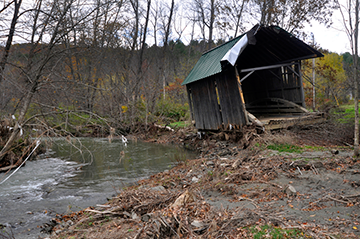
States deployed 1,130 personnel to the upper East Coast in response to Hurricane Irene & Tropical Storm Lee.
North Carolina had pre-scripted missions for deployment that were stood down after determining the path of the storm did not necessitate external resources. Download the EMAC After Action Report to learn more.
- Connecticut - 5
- Delaware - 6
- Massachusetts - 9
- Maryland - 2
- Virginia - 8
- New Jersey - 155
- New York - 158
97% Civilian (state and local)
3% National Guard
2011
Hurricane Sandy

New Jersey - 1226 personnel
Maryland - 129 personnel
New York - 1263 personnel
Pennsylvania - 4 personnel
Massachusetts - 4 personnel
Connecticut - 5 personnel
In total, 2,631personnel were deployed by states in response to Hurricane Sandy. While Delaware and Vermont opened events in the EMAC Operations System and identified potential resource, they did not require assistance.
National EMAC Liaison Teams (NELT) were at FEMA's National Response Coordination Center (NRCC) to help coordinate the EMAC response through the states with the federal response.
2012
Severe Snow Event
 The February 2013 nor'easter (also called Winter Storm Nemo) caused heavy snowfall and hurricane force winds. All New England states declared states of emergency. Over 700,000 customers were without power and at least 18 deaths were attributed to the storm.
The February 2013 nor'easter (also called Winter Storm Nemo) caused heavy snowfall and hurricane force winds. All New England states declared states of emergency. Over 700,000 customers were without power and at least 18 deaths were attributed to the storm.
Through EMAC, 161 personnel (89% National Guard and 11% civilian) were deployed through EMAC to assist.
Photo Credit: NASA
2013
Colorado Fires
 National Guard aerial water dropping resources were deployed through EMAC in support of both the West Fork Complex and the Black Forest fires in Colorado. Over 14,000 acres and 509 homes were destroyed. Three missions of UH-60s, one for medical evacuations and two with bambi buckets for water dropping missions were deployed with 14 PAX.
National Guard aerial water dropping resources were deployed through EMAC in support of both the West Fork Complex and the Black Forest fires in Colorado. Over 14,000 acres and 509 homes were destroyed. Three missions of UH-60s, one for medical evacuations and two with bambi buckets for water dropping missions were deployed with 14 PAX. Photo Credit: US Army
2013
National Boy Scout Jamboree
 The 18th National Boy Scout Jamboree held at the Summit Bechtel Reserve in West Virginia was supported with EMAC deployed resources through 5 missions with 44 personnel to support this national special security event.
The 18th National Boy Scout Jamboree held at the Summit Bechtel Reserve in West Virginia was supported with EMAC deployed resources through 5 missions with 44 personnel to support this national special security event.
This was the first time in 30 years that the jamboree was not held at Fort A.P. Hill, a US Army installation that had hosted every jamboree since 1981.
Photo Credit: U.S. Department of Defense
2013
Severe Flooding - Colorado
 164 personnel from 14 states (AL, AZ, CA, FL, IA, KS, KY, LA, MT, PA, SD, TN, UT, WY) completed 34 missions in Colorado in response to flooding that started in September 2013 and continued through March 2014.
164 personnel from 14 states (AL, AZ, CA, FL, IA, KS, KY, LA, MT, PA, SD, TN, UT, WY) completed 34 missions in Colorado in response to flooding that started in September 2013 and continued through March 2014.
Resources ranged from search and rescue, hazard mitigation grant specialists, dam inspectors, road engineers, to public assistance.
Of the 164 personnel who responded, 67% were National Guard and 33% were civilian.
2013
10 Years of Improvements Following Hurricane Katrina
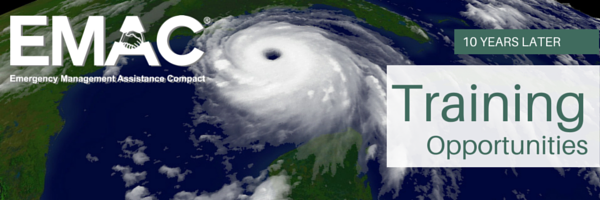 This epic 2005 hurricane season resulted in many lessons learned and improvements to our national mutual aid system:
This epic 2005 hurricane season resulted in many lessons learned and improvements to our national mutual aid system:- Reimbursement turnaround went from over a year to just a few weeks after receiving the reimbursement package
- Mission Ready Packages (MRPs) - specific response and recovery capabilities that are developed by Resource Providers, organized, trained, and exercised prior to an emergency or disaster are a key to speeding response
- Public Health and Medical templates for Mission Ready Packages (MRPs) - discipline specific templates that focuses on the most frequently requested resources
- Development of the Mutual Aid Support System – a free online GIS inventory of Mission Ready Packages for Resource Providers and State Emergency Management Agencies
- Establishment and maintenance of the EMAC Advisory Group to ensure disciplines are integrated into the EMAC response – with membership from response and recovery organizations across the nation
- Training has grown from two courses to seven and an EMAC app for deploying personnel to receive just in time training
- Improvements in accountability of deployed personnel
2015
Republican National Convention
 When Cleveland, Ohio was to host the Republican National Convention one of the needs was for additional law enforcement to maintain the safety and security of their City with the influx of attendees. Intrastate mutual aid filled some of the need; but they still lacked significant forces to implement their operations plan.
When Cleveland, Ohio was to host the Republican National Convention one of the needs was for additional law enforcement to maintain the safety and security of their City with the influx of attendees. Intrastate mutual aid filled some of the need; but they still lacked significant forces to implement their operations plan. Download and read the lessons learned, areas for improvement, and what worked well!
2016
Hurricanes Harvey, Maria and Irma
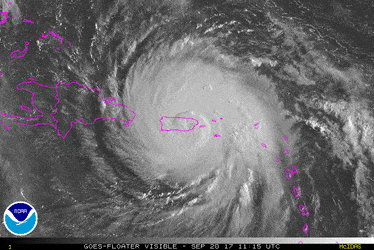
The 2017 hurricane season was the fifth most active season in recorded history (to date). Over 45 states deployed 16,556 responders to support EMAC missions during Hurricanes Harvey, Irma, and Maria.
The critical role EMAC plays in disaster response is apparent from the response numbers. EMAC is the backbone of the nation's mutual aid system.
During the events, EMAC leadership identified some key areas for improvement most notably changing the EMAC paperwork process from 3 parts to 2.
The proposed change was voted upon at the March 2018 NEMA Forum and it was agreed upon by all of the NEMA membership to retire the EMAC Request for Assistance Form (REQ-A) and replace it with a two part Resource Support Agreement (RSA).
This change impacted all EMAC documents, training courses, and documents. The updated EMAC Operations System (EOS 3.0) was completed in 2019 making EMAC response even faster!
Download the 2017 After Action Report
Photo Credit: NOAA
2017
California Wildfires
 The 2017 California wildfires were some of the most destructive in history with 9,560 fires burning 1,548,429 acres of land. California reported 47 people - 45 civilians and 2 firefighters were killed by the fires.
The 2017 California wildfires were some of the most destructive in history with 9,560 fires burning 1,548,429 acres of land. California reported 47 people - 45 civilians and 2 firefighters were killed by the fires.
The fires were fueled by the strong Santa Ana winds.
States sent 1,795 personnel and equipment (firefighters and incident management teams) to assist.
Image credit: NASA
2017
California Fires
The 2018 California wildfires were the deadliest and most destructive in California's history - surpassing the records set in 2017.
A total of 103 confirmed fatalities, 24,226 structures damaged or destroyed, and 8,527 fires burning destroying 1,975,086 acres.
The Carr Fire, Woosley Fire and Camp Fire which destroyed the town of Paradise will forever be etched in history. Deployments in support of the 2018 California wildfire season included National Guard, firefighters, mass care, volunteer and donations management, public assistance and forensics - 1,295 personnel and equipment. Download the AAR from the 2018 and 2019 California Wildfires.
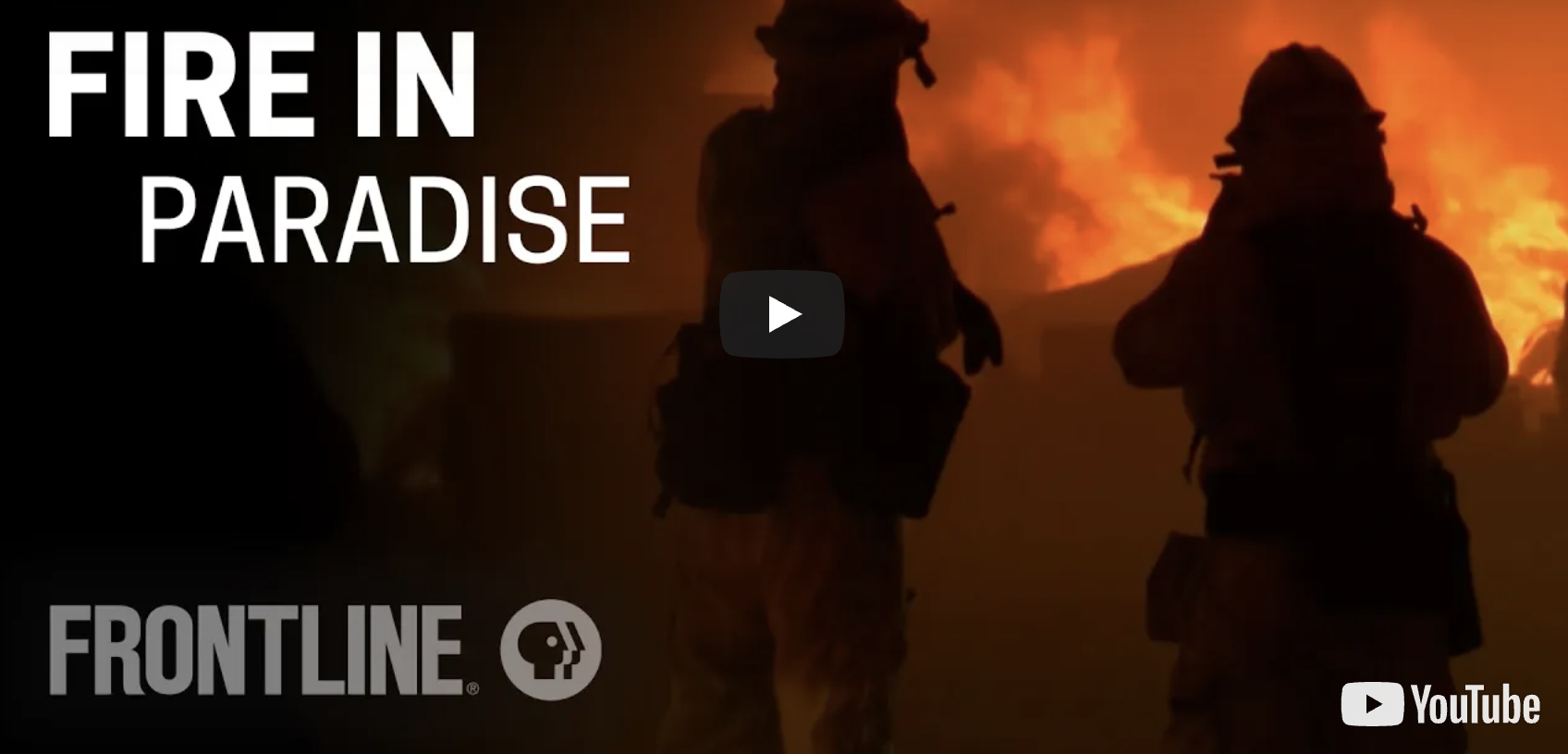
Video Credit: Frontline. PBS.
2018
California Wildfires
The Diablo and Santa Ana winds were again a factor in the 2019 California wildfire season in October and December. Six states (ID, OR, MT, WA, UT, NM) sent 641 firefighters with equipment to assist in containing some of the 7,860 fires that burned 259,823 acres of land.
Download the AAR from the 2018 and 2019 California Wildfires.
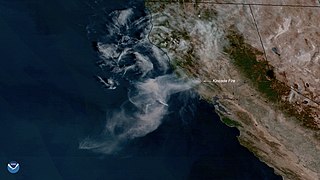
Photo credit: NOAA satellite image
2019
Puerto Rico Earthquake

Starting on December 28, 2019, and progressing into 2021, the southwestern part of the island of Puerto Rico was struck by a series of earthquakes including 11 that were of magnitude 5 or greater.
Seven states (CA, OH, NY, NM, NJ, LA, NC ) sent 489 personnel including National Guard, building inspectors, mass care, law enforcement, geologists and more to assist.
Photo credit: Map of southwestern Puerto Rico and its offshore area showing topography taken from the NOAA DEM Color Shaded Relief layer with the location of active faults taken from Bruna et al. 2015 and Mann et al. 2005 and epicentres of earthquakes of the 2019-2020 Puerto Rico earthquake sequence taken from ANSS
2020
Hurricane Laura and Tropical Storm Marco
Tropical Storm Marco hit Louisiana on August 24 as a tropical storm and Hurricane Laura hit Louisiana on August 27 as a major hurricane.
Search and rescue, building inspectors, mass care, National Guard, Department of Transportation resources, incident management teams and more to assist (400 personnel with equipment and supplies). Thank you to Alabama, Florida, Mississippi, North Carolina, Oklahoma, South Carolina, Tennessee, Texas and Washington).
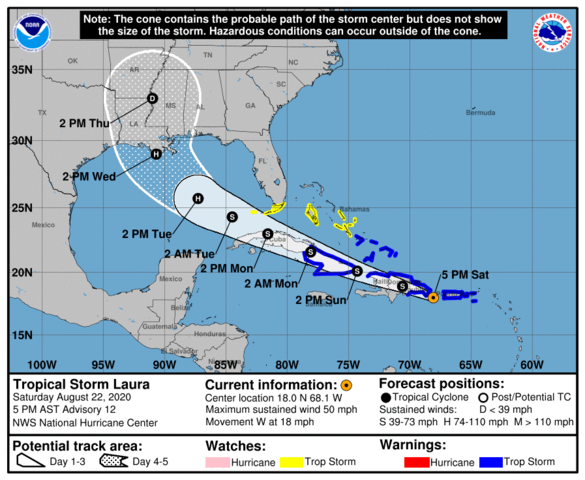 Photo credit: By National Hurricane Center - Hurricane Laura 2020 graphics archive, Public Domain, https://commons.wikimedia.org/w/index.php?curid=93526218
Photo credit: By National Hurricane Center - Hurricane Laura 2020 graphics archive, Public Domain, https://commons.wikimedia.org/w/index.php?curid=93526218
2020
Oregon Wildfires
 The 2020 Oregon wildfire season was one of Oregon's most destructive on record. The fires killed at least 11 people, burned more than 1,000,000 acres of land and destroyed thousands of homes. Firefighters, public information officers, EOC manager, logistics support, volunteer and donations management, GIS support, human services, communications and more from 36 states deployed 238 personnel.
The 2020 Oregon wildfire season was one of Oregon's most destructive on record. The fires killed at least 11 people, burned more than 1,000,000 acres of land and destroyed thousands of homes. Firefighters, public information officers, EOC manager, logistics support, volunteer and donations management, GIS support, human services, communications and more from 36 states deployed 238 personnel.
Photo credit: By Phoenix7777 - Own workData source: MODIS Active Fire Detections for CONUS (2020), Geospatial Technology and Applications Center, U.S. Forest Service, USDAShapefile: modis_fire_2020_272_conus_shapefile.zip (Initial upload) Map: Open Street Map, CC BY-SA 4.0, https://commons.wikimedia.org/w/index.php?curid=94637991
2020
California Wildfires
The 2020 California wildfires were again a record setting year with 9,639 fires burning 4,397,809 acres. A combination of a record-breaking heat wave and strong katabatic winds (including the Jarbo, Diablo, and Santa Ana) caused rapid fire growth.
14 states deployed 787 personnel to assist in the wildfire response (National Guard, firefighters, equipment).

Image credit: Christopher Michel https://www.flickr.com/photos/cmichel67/50324416696/
2020
EMAC Celebrates 25 Years as the Nation's Preeminent Mutual Aid System
55 Members Strong and 25 Years of Saving Lives and minimizing the impact to the economy and the environment. We are so incredibly grateful to everyone who has deployed on an EMAC mission and everyone who works behind the scenes to make EMAC work. This video celebrates EMAC's 25 years!
